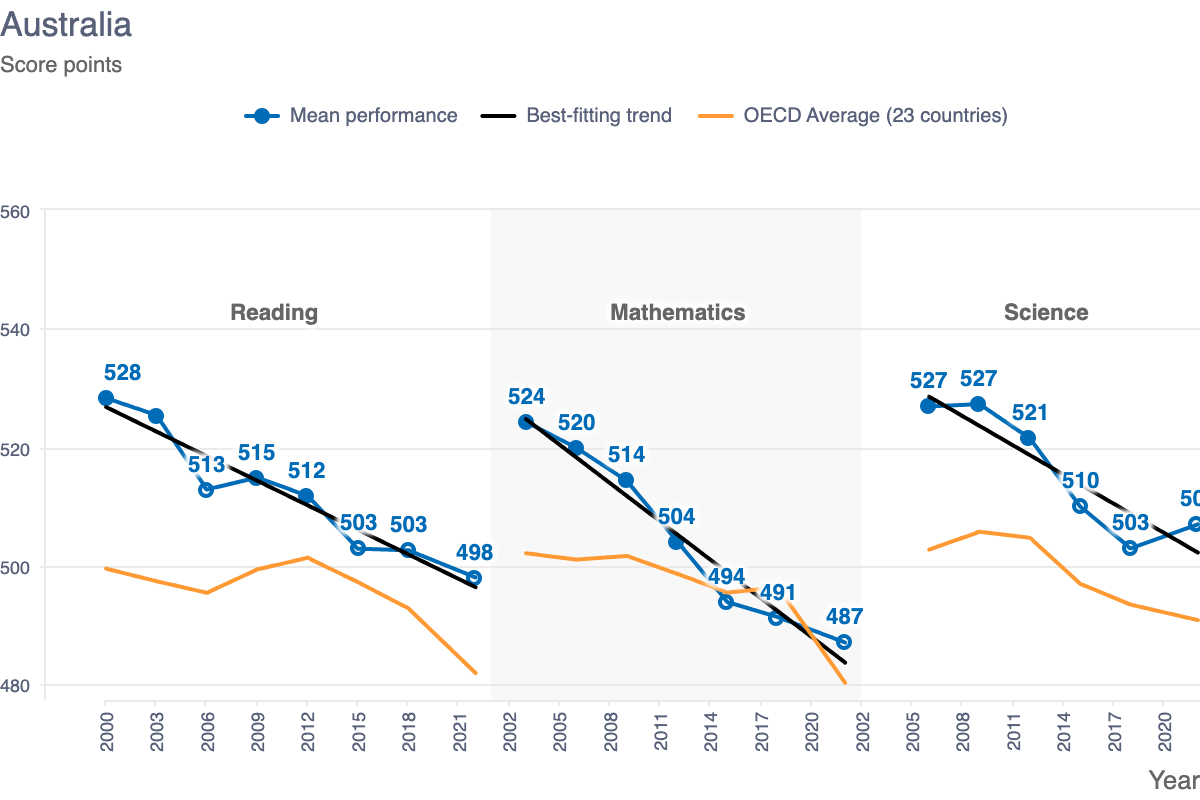Gap between high and low achieving students in Australia is widening
The Organisation for Economic Co-operation and Development (OECD) have released the PISA 2022 Results (Volume I): The State of Learning and Equity in Education report, which reveals that the gap between high and low achieving students in Australia is widening.
The OECD is an intergovernmental organisation with 38 member countries (of which Australia is one), founded in 1961 to stimulate economic progress and world trade. The organisations Programme for International Student Assessment (PISA) assesses the knowledge and skills of 15-year-old students in mathematics, reading and science. The tests explore how well students can solve complex problems, think critically and communicate effectively, giving insight into how well education systems are preparing students for real life challenges and future success. Australia participated for the first time in PISA in 2000. By comparing results internationally, policy makers and educators can learn from other countries’ policies and practices.
So how did Australia fare?
Australia’s Performance in Education (PISA 2022):
- Mathematics:
- Australia scored 487 points, which is above the OECD average (472 points). This positions Australia among the 18 countries that performed above the OECD average.
- Australia’s long-term performance in mathematics has been in decline, with a drop of 15.8 points over the past 10 years?.
- Reading:
- Australia scored 498 points in reading, maintaining a relatively stable position, though with a decrease of 12.5 points over the last decade?.
- Science:
- In science, Australia scored 507 points, which is again above the OECD average (485 points). However, like in other subjects, Australia’s performance has slightly declined, dropping by 14.4 points over the past 10 years?.

One key contributor to this decline in scores has been signalled as a shortage of teaching staff. In 2022, 61% of students in Australia were in schools whose principal reported that the school’s capacity to provide instruction is hindered by a lack of teaching staff (and 27%, by inadequate or poorly qualified teaching staff). In 2018, those corresponding proportions were 17% and 14%. In most countries/economies, students attending schools whose principal reported shortages of teaching staff scored lower in mathematics than students in schools whose principal reported fewer or no shortages of teaching staff.
Comparative Performance:
- Australia ranks alongside countries like Canada, Finland, Japan, and Singapore, which combine high achievement and socio-economic equity in education?.
- However, the gap in learning outcomes between high- and low-achieving students in Australia has widened, particularly in mathematics?.
Decline in Top Performers:
- Over the last decade, the percentage of top-performing students (those scoring at proficiency levels 5 or 6) has decreased by 2.5% in mathematics, while the share of low-performing students (below level 2) has increased by 6.7%?
Socio-Economic Gaps:
- The performance gap between advantaged and disadvantaged students in Australia is significant, with advantaged students consistently outperforming their disadvantaged peers?.
Global Context:
- Globally, countries like Singapore, Macao (China), Chinese Taipei, and Hong Kong (China) lead in all three core subjects of mathematics, reading, and science?.
So while Australia performs above the OECD average in key areas, the overall trend shows a decline in both average performance and equity, particularly in mathematics and science. The gap between high and low achievers has also widened – with concerns raised around academic equity.
This includes:
Socio-economic Disparities: The performance gap between advantaged and disadvantaged students is notable in Australia. In particular, Australia’s socio-economic disparities are reflected in the widening performance gap between high- and low-achieving students, especially in mathematics. In fact, the gap between the top and bottom quartile of socio-economic status (ESCS) has widened?.
Targeting Equity: Australia could benefit from targeted interventions focusing on disadvantaged schools and students. The report suggests that policies in Australia should focus on improving the performance of individual disadvantaged students rather than targeting schools?.
Educational Inclusion: Australia has been identified as needing to strengthen efforts in inclusion as well as equity. The PISA 2022 findings show that while Australia is resilient in terms of mathematics performance, it still struggles with equitable outcomes for disadvantaged students, which suggests that fairness in the distribution of educational outcomes is an area for improvement?.
Global Comparison: Despite some challenges, Australia ranks alongside countries like Canada and New Zealand that are working toward more equitable education systems. However, compared to top-performing countries in equity such as Finland and Denmark, Australia has room to improve in ensuring both high academic performance and fairness in socio-economic outcomes.
Australia’s focus on addressing these disparities through targeted policies and further inclusion is crucial for improving equity across the education system.
Key directives for the Australian education system
The report outlined some key directives for the Australian education system that focus on improving equity, performance, and resilience in response to both long-standing trends and recent challenges like the COVID-19 pandemic. These include:
- Resilience in Education Systems: The document emphasises the importance of resilience in education systems. Australia was noted for maintaining resilience in mathematics performance but not in equity or student well-being. It recommends keeping schools open longer (in response to covid lockdowns) and ensuring remote learning runs smoothly to maintain educational progress during disruptions .
- Equity and Inclusion: Australia’s socio-economic disparities in education outcomes are significant, and policies need to focus on reducing the performance gap between advantaged and disadvantaged students. The report suggests that Australia could benefit from focusing on individual students rather than schools, to address the widening gap in learning outcomes .
- School Autonomy with Accountability: Schools in Australia have been encouraged to embrace greater autonomy, but this should be coupled with strong quality-assurance mechanisms like teacher mentoring and regular standardised assessments .
- Teacher Support and Professional Development: Addressing teacher shortages and enhancing teacher support mechanisms are highlighted as vital steps to ensure students receive the assistance they need, particularly in times of disruption .
- Investment in Early Childhood Education: Attendance at pre-primary school is linked to reduced grade repetition, showing the importance of early educational investment in long-term student success .
These directives reflect an ongoing effort to balance autonomy with accountability, focus on equity, and strengthen the resilience of Australia’s education system.




